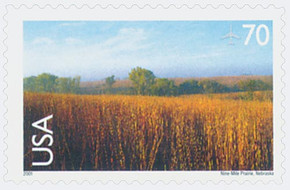
U.S. #C139
2006 63¢ Bryce Canyon National Park
Scenic American Landscapes
Issue Date: February 24, 2006
First City: St. Louis, Missouri
Quantity Issued: 100,000,000
Printed by: Banknote Corporation of America for Sennett Security Products
Printing Method: Lithographed... more
U.S. #C139
2006 63¢ Bryce Canyon National Park
Scenic American Landscapes
Issue Date: February 24, 2006
First City: St. Louis, Missouri
Quantity Issued: 100,000,000
Printed by: Banknote Corporation of America for Sennett Security Products
Printing Method: Lithographed
Perforation: Serpentine Die Cut 10 ¾
Color: Multicolored
This stamp was issued to pay the 63¢ letter rate to Mexico and Canada. Bryce Canyon is located in southwestern Utah. It was named after the Mormon pioneer Ebenezer Bryce and established as a small National Park in 1924. Its unique geology consists of a series of horseshoe-shaped amphitheaters and spires formed in colorful limestone. This is the seventh issue of the Scenic American Landscapes Series.
Antiquities Act Of 1906
On June 8, 1906, President Theodore Roosevelt signed the Antiquities Act into law, giving him and future presidents the authority to create national monuments from federal lands.
Roosevelt was an avid outdoorsman. After the death of his first wife in 1884, Roosevelt moved to the North Dakota Badlands where he set up a ranch. When Roosevelt first came to the Badlands, it was as a hunter. But it was his interest in livestock and cattle ranching that made him stay.
For a handful of years, Roosevelt made his home in the Badlands, adopting the western way of life. But he also spent many hours reflecting on the ever-changing landscape around him. Some of the animals there, such as the bison, had been over-hunted to near extinction. The landscape had changed as well. Early on, Roosevelt noticed the toll overgrazing was taking on the natural community.
Though Roosevelt soon gave up on ranching, he did not forget the important lessons he learned about conserving our natural resources, writing “We have become great because of the lavish use of our resources. But the time has come to inquire seriously what will happen when our forests are gone, when the coal, the iron, the oil, and the gas are exhausted, when the soils have still further impoverished and washed into the streams, polluting the rivers, denuding the fields and obstructing navigation.”
Roosevelt’s concern for nature continued to grow over time and when he became president in 1901 he had the authority to enact sweeping changes. Considered America’s first conservationist president, Roosevelt dedicated much of his time in the White House to protecting natural resources. He pushed for the Newlands Reclamation Act of 1902, which provided for federal construction of dams to irrigate farms. It also placed 230 million acres under federal protection.
During his term, Roosevelt set aside more federal land, national parks, and nature preserves than all the presidents before him combined. He established the US Forest Service and created five new National Parks – Crater Lake in Oregon, Wind Cave in South Dakota, Sullys Hill in North Dakota, Mesa Verde in Colorado, and Platt in Oklahoma.
By the early 1900s, “pot hunters” had removed large numbers of Native American artifacts from prehistoric ruins that had little to no protection. Congressman John F. Lacy and anthropologist Edgar Lee Hewett worked together to explore the archeological resources in the area, and their report was a major inspiration for the Antiquities Act.
Introduced on January 9, 1906, the Antiquities Act passed the House and Senate in early June and was signed into law by President Roosevelt on June 8, 1906. While it was initially passed to protect prehistoric Native American ruins and artifacts on federal lands, it also authorized presidents to proclaim “historic landmarks, historic and prehistoric structures, and other objects of historic or scientific interest” as “national monuments.” Roosevelt used a reference in the Act to “objects of scientific interest.” He named Devils Tower as the first national monument three months after the Act was passed. He would create 17 more National Monuments during his time in office.
Since it was passed, the act has been used over 100 times. The purpose of the document is “the protection of objects of historic and scientific interest.” Although national parks effectively do the same thing, because they need to be approved by Congress, the process takes a lot longer – when the president makes an official proclamation, the area is protected immediately. Since the act was passed, 16 presidents have created 157 National Monuments, with President Obama holding the record at 26 monuments totaling 550 million acres.
Click here to read the text of the act and click here to view a list (with links to more info) about each of the National Monuments created under the act.
Less

Most Orders Ship
within 1 Business Day
90 Day Return Policy
Satisfaction Guaranteed
Earn Reward Points
for FREE Stamps & More













